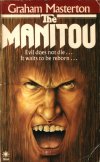 The Manitou Star 1980
The Manitou Star 1980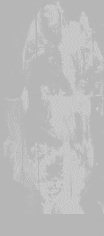

In many ways Graham Masterton is one of the old guard of horror authors, his novels among the earliest paving the way for the boom in horror that occured during the eighties. Few rode that particular storm and came out still at the top of the game, the only authors still regularly making the bestseller lists are Stephen King and James Herbert. Graham Masterton never really reached the heights that those two achieved, most likely because of the subject matter of his books. He has struck firmly to the path of supernatural horror, becoming one of its most strident standard bearers, and over the decades he has barely wavered in that quest.
He takes on the age old theme of ancient evil locked away until someone awakens it and enbues it with new life. Approaching it in a way almost entirely his own. He takes inspiration from all forms of popular myth, legend, fairy tale and childrens rhyme and weaves them into the tropes of modern horror. It seems effortless, giving the original a whole new spin and lifting what might be a modern horror cliche to a new level. That is why, despite the constant flow of novels from his pen, that new novels are always so eagerly anticipated.
His novels are usually tales of normality overwhelmed by the alien, the characters rarely go looking for adventure, the horror is thrust upon them against their will. In a way like Kafka, but a nightmare bureaucracy is replaced by a power willing to strip away more than just freedom. They want your partner, they want your children. They walk the line between amoral and immoral. They are seemingly unstoppable, and sometimes are, but occasionally their might be a chink in their armour. Those who survive are those who cling to their humanity despite it all, who survive their loss and find an inner core of strength. Despite the presence of the supernatural, his novels represent humanism to the core.
 The Manitou Star 1980
The Manitou Star 1980Masterton's early horror fiction is very stripped down and to the point, thin novels which concentrate on the central narrative and nothing else, providing story rather than a preponderance of distractions. The first was The Manitou (1975). It is an entertaining work, about a subject Masterton has returned to many times, that of Native American Demons. The novel itself is enjoyable enough but let down slightly by the ending. It has thus far been the only Masterton novel to be adapted to film, and the film is passable but not really exceptional. Several other Masterton novels have been optioned for the screen, though none of the others have made it much further.
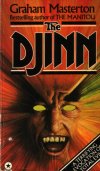 Djinn Star 1977
Djinn Star 1977
With his second horror novel, The Djinn (1976) Masterton returns to the subject of demonology, but this time the demon is a Djinn, an Arabian spirit trapped in an ancient jar, which is let loose. It is in a similar vein to The Manitou.
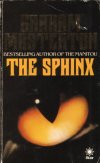 The Sphinx Star 1981
The Sphinx Star 1981His next novel The Sphinx (1978) was something of a departure and is a novel that doesn't really seem to fit in with the rest of his work. Nevertheless it is an interesting and pretty original tale about the survivors of a race of ancient Cat People surviving to the modern day. The was also the first time he really attempted to use eroticism in his horror novels, and though it worked to a certain extent and was central to the novel, it didn't work as well as in his later novels.
Next was Charnel House (1978) released in the same year and finally showing what Masterton was really capable of. The novel itself centres around an investigation into a house that has a strange life of its own. What seems at first to be a typical haunted house novel soon becomes something a little more original, with a demon staging its own resurrection in a horrific way. To say much more would spoil too much of the plot, suffice to say that this the first essential Masterton novel, very brief, fast paced and to the point.
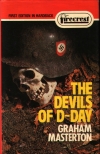 The Devils of D-Day Chivers Press 1983
The Devils of D-Day Chivers Press 1983The Devils of D-Day (1978) was an attempt at tying together several different myths (invented or otherwise) and a different twist on a historical event. We've become used to reading novels where the Nazis use Black Magic to help with their ends (Masterton himself was to cover that subject over a decade later) but in this it is the Allies who have made use of demonic aid. A rusted tank, old and tightly sealed, is the only remaining artifact of the truth. The confrontation at the end of this novel is superb, and shows how far Masterton had come in terms of story telling since The Manitou, with an angelic presence which reveals itself just as terrifying as any demon.
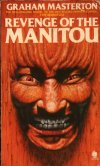 The Revenge of the Manitou Sphere 1980
The Revenge of the Manitou Sphere 1980This is a far cry from the relatively disappointing Revenge of the Manitou (1979). In itself it isn't a bad novel, though it is merely a retread of The Manitou and doesn't really add much to the previous novel. As a replacement of The Manitou it might be seen in a better light though, improving upon the aspects from the first that were slightly lacking. I may be being a little harsh, as it was different to The Manitou, though it was largely unnecessary.
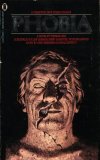 Phobia Sphere 19??
Phobia Sphere 19??Then came a period where Masterton wrote under the pseudonym of Thomas Luke, initially to do a book based on a screenplay but then some original novels. The "book of the screenplay" was Phobia (1980) and suffers the same fate of most adaptations of mediocre films. Had the novel been fully in Masterton's control it might have been something great, as it is, it is merely something to read on a rainy day.
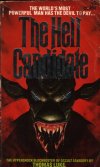 The Hell Candidate Sphere 19??
The Hell Candidate Sphere 19??The Hell Candidate (1980) is something of an improvement, introducing another of Masterton's abiding influences and that is the corrupting effects of power. In this case it is a presidential candidate who appears to have made a deal with a higher power to ensure his success. The novel is Masterton's first lengthy novel and as such has a few weaknesses, the first part is overlong and seems to spend to much time reiterating the same fact. In the second part the novel really starts moving though, and it is well worth living through the first section to reach it.
 The Heirloom Sphere 1981
The Heirloom Sphere 1981The Heirloom (1981) was released in the UK under Masterton's own name, but I think it was released as by Thomas Luke in the US. Again this is a short novel, much in the vein of the earlier novels Charnel House and Devils of D-Day. Like those though, it takes a very different look at a similar subject. This time a family comes into the possession of an antique chair, which gradually takes on a unique life of its own. I won't hold this book up as great literature, but as with much of Masterton's early work, it is a breeze to read and a very enjoyable way to spend a few hours.
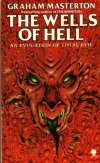 The Wells of Hell Sphere 1981
The Wells of Hell Sphere 1981The Wells of Hell (1981) is quite an interesting attempt at a Lovecraft tribute, based as it is upon the actions of a rather ancient dreamer whose spawn transform a seemingly normal rural family through their polluted water supply. Another of his short and entertaining novels, this is also the last novel of what I consider his first phase, the next novel is quite a departure.
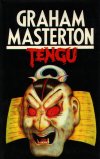 Tengu Severn House 1987
Tengu Severn House 1987Tengu (1983) is a more substantial novel (not merely in page count) and quite a bit darker than anything he had done before. He begins to make more use of erotic elements (often uncomfortable) as well as more graphic violence. One thing Masterton is generally capable of though is not using excessive violence, when he uses violence it generally has a connection to the plot. In this case it just adds to the power of the book, a tale of the Japanese underworld seeking to revenge itself upon America for Hiroshima by using their knowledge of an ancient Japanese evil. What makes this novels most impressive is its utter bleakness, and the ending is both surprising and abrupt. It combines elements from some of Masterton's political thriller novels and for the most part the combination works really well. Not a book to read if you want cheering up.
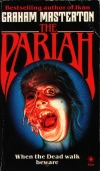 The Pariah Star 1983
The Pariah Star 1983The Pariah (1983) is in my opinion one of Masterton's absolute best, walking the line between the different aspects of his oeuvre and bringing his Lovecraftian influences to the fore. This time he incorporates aspects of spiritualism, as a decaying wreck at the bottom of the sea exerts a strange influence over the spirits of the recently departed and through them, their loved ones. A tale partially built up from research into a mysterious sea voyage, and the gradual transformation of the novel as it moves towards its final stages, when the cargo within the ships hold is finally released. What this novel most reveals is Masterton's ability to weave a tale that seems to be one thing then through an act of almost alchemical genius twists it into something else altogether. A highly recommended and highly enjoyable work.
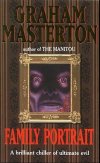 Family Portrait Sphere 19??
Family Portrait Sphere 19??Family Portrait [Picture of Evil] (1985) is another masterpiece as this time the novel centres around a quite horrendously decadent family. A work very much influenced by Wilde's The Picture of Dorian Grey, it twists and turns with a great energy as the secrets are gradually exposed. Again there are elements of a twisted eroticism, hinting at dark and forbidden things, and a great overpowering decadence and decay. Again this shows elements of Masterton's alchemical magic, combining different tales into a greater whole, and is a great addition to his body of work. This was probably his most creative period, or at least the time when he really started to make use of his creative energy, and he produced some of his greatest work.
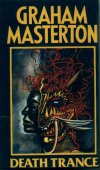 Death Trance Severn House 1987
Death Trance Severn House 1987After this Death Trance (1986) looks at the lengths the bereaved will go to to contact their loved ones, even as far as putting both them and their loved ones, though already dead, in great danger. A spiritual trance which allows entry into a nether realm occupied by the dead and a group of frightening and evil scavengers.
Books which turn into sequels then trilogies often have a way of drifting into their own twisted oblivion, but with the first book of what was to become the Night Warriors trilogy Night Warriors (1986) Masterton moves away from complete mundane reality into more fantastical realms. It is a move which works surprisingly well though some may find the fantasy elements a bit irksome. This time we are shown Masterton's vision of the dream realms, and their protectors, a group of reluctant heroes who don fantastic garb and defend sleepers against a great evil moving into people's dreams. The action is fast and furious, and recognisably erring on the side of horror rather than fantasy as in fantasy you rarely have a body count this high, and fantasy doesn't often get quite so dark.
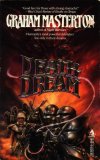 Death Dream Tor 1988
Death Dream Tor 1988Death Dream (1988) returns to the world of the Night Warriors, reduced in numbers and needing to recruit more to fight against another great evil threatening dreams. This doesn't suffer from sequel fatigue mainly because of its different approach to the subject matter.
Mirror (1988) is another one of his best, partially about obsession it looks at how a man's great desire for all things Boofuls (an angelic child star murdered horrifically) leads him to uncover a great secret. This is another novel which twists and turns through a imaginative series of hoops before reaching its powerful denouement, as a mirror which looked upon the child's horrific murder acts as conduit for past evils. The novel works on a series of discoveries, each more horrific than the last, which all gather seamlessly together to form the great final secret of the novel in which decadence again reigns supreme.
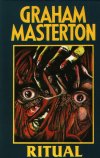 Ritual Severn House 1988
Ritual Severn House 1988And there's decadence and then there's Ritual [Feast] (1988) a novel that takes decadence to its horrific conclusion where a restaurant critic is drawn into the world of a strange cannibalistic cult with roots in both Voodoo and Christianity. It is frequently stomach churning, though never over the top, and amounts to a general feeling of discomfort that works perfectly with the novel.
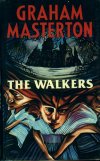 Walkers Severn House 1990
Walkers Severn House 1990Walkers (1989) is another very original novel with a child's rhyme at its core, something Masterton has increasingly been using as a basis for his novels. Though in this case the rhyme holds the key to some old druidic magic that allows the criminally insane inmates of an asylum to find their escape. A slightly strange yet enjoyable ride.
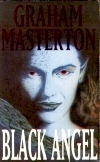 Black Angel Mandarin 1991
Black Angel Mandarin 1991He followed this with Black Angel [Master of Lies] (1991), a very bleak novel at least as dark as Tengu that has some of the most graphically violent scenes Masterton has ever written. It is definitely one to be avoided if you're at all squeamish, imagine a darker, gorier version of the movie Seven (which this novel predates). This time about a ritualistic serial killer dubbed the Fog City Satan who kills in almost unimaginable ways, paving the way for the awakening of one of the fallen angels. The story is very noir and has quite a bit of pulpish flair, definitely worth reading if you can stomach the gore.
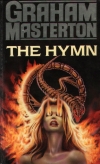 The Hymn Macdonald 1991
The Hymn Macdonald 1991The Hymn [The Burning] (1991) is another one of my favourites, combining several elements to create a great original novel. It begins with a suicide that has repercussions through the whole novel, which again explores the subject of decadence quite deeply touching on Nazism and its fascination with black magic along the way, as the seeds are sown for the rise of the Forth Reich. Great powerful stuff and definitely the novel to read if you're into Nazi/Black Magic conspiracy theories whilst being fresh and original enough for you to enjoy even if you're not.
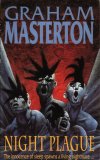 Night Plague Warner 1994
Night Plague Warner 1994Night Plague (1991) returns for the third time to the story of the Night Warriors and is the most powerful of the three, where one of the Night Warriors succumbs to a sexual disease through a violent male rape and has to suffer through a great deal before they confront the force that threatens to undermine the sanctity of the Night Warriors. It sounds very much pulp fantasy stuff but this novel is very dark, the influence of AIDS on the story is very obvious, and the particularly unpleasant start sets the theme for the whole novel. This is far more grounded in reality than the other two.
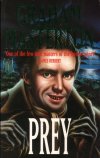 Prey Mandarin 1992
Prey Mandarin 1992Next comes Prey (1992), another Lovecraft tribute, this time based upon his story The Dreams in the Witch House. This is without doubt the best novel of the "Cthulhu Mythos" I have read so far, he manages to bring Keziah Mason and her hideous familiar Brown Jenkin into a twisted life, the strange effects of the house that doesn't quite obey standard geometry and a tale of lost orphans; all combine into a really compelling story.
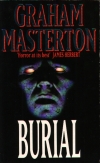 Burial Sphere 19??
Burial Sphere 19??Burial (1992) is yet another "final part of a trilogy" but unlike the first two parts The Manitou and Revenge of the Manitou, this is a really great novel. The American Indian Medicine man returns to get revenge on the American people for the devastation they wrought upon his, massacres occur in the same locations of the massacres of history. It is one of Masterton's few apocalyptic horror novels, the Tengu being the only other one that really classifies as such, most of Masterton's novels deal with a small group of people dealing with the supernatural, this one paints of a wider canvas.
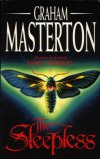 Burial Mandarin 1994
Burial Mandarin 1994His next novel, The Sleepless (1993) I found to be something of a disappointment, as the graphic violence undermined what might have been a pretty effective novel. This is basically a conspiracy novel with a supernatural twist, and works in a sense, but is far from Masterton's greatest.
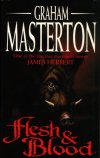 Flesh and Blood Mandarin 1995
Flesh and Blood Mandarin 1995Flesh and Blood (1994) is a novel destroyed by its own complexity, with Masterton's usual control slipping as he tries to juggle disparate elements which just don't gel together at all. Somewhere in this novel was a great one trying to get out, but a large segment of the plot, about a giant genetically engineered pig just dragged it down completely. The other plot, about the mysterious and deadly Green Traveller, was far more interesting.
 Spirit William Heinmann 1995
Spirit William Heinmann 1995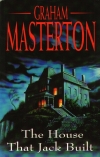 The House That Jack Built BCA 1996
The House That Jack Built BCA 1996The House That Jack Built (1996) is another big jump in the right direction, a superb novel about a house haunted by a spirit from its past. This may sound a very traditional idea but Masterton injects it with a great deal of originality and the book all has the strengths of vintage Masterton whilst remaining utterly new, exploring territory he has never really covered before, as much about the breakdown of relationships as the impingement of an horrific evil presence from the past.
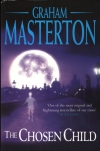 The Chosen Child William Heinmann 1997
The Chosen Child William Heinmann 1997He followed up this with The Chosen Child (1997) and again he is really in his element. Set wholly in Poland, the plot revolves around a series of brutal and inexplicable murders in the area of a building site. The murders are tied to an old Polish legend, dating back to the Second World War, based around something the Polish Resistance met in the Sewers. As the novel unravels towards its incredible conclusion a bizarre truth is revealed, and the evil behind the murders is exposed in a completely different light.
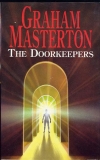 The Doorkeepers Severn House 2000
The Doorkeepers Severn House 2000When Masterton takes a step into parallel worlds it is always a pleasure and The Doorkeepers (2000) is no exception. The doors in question lead to a multitude of parallel Londons, lorded over by some rather vicious puritans. It is well written novel that opens the new millennium in style, showing an author who is both confident and at the height of his powers.
This page has merely been a brief introduction to his work, merely the opinions of one of his avid readers, so I heartily recommend that everyone should hunt down his novels and make up their own minds. I intend this to grow with time, to explore some of his short fiction and expand upon the discussion of each of the novels, but will read each of them again first to make sure I do them justice. However you approach Masterton, and whether or not you agree with my opinions of his novels, you will undoubtedly find that Masterton has a lot to offer, and not just to horror fiction, but literature in general.
Amongst Masterton's other recent works is a series of young adult horror novels about the school teacher Jim Rook. There are currently three of them, only available in hardback, called Rook (1996), Rook II : Tooth and Claw (1997) and Rook III : The Terror (1998). The first is an interesting tale about Voodoo, and works well in the context of a teenage novel without ever being condescending. Whilst more restrained in terms of gore it doesn't pull its punches and will delight many teenage horror fans and even has something to offer to his more adult readers. I have yet to read the second volumes but the third is a book very much in the vein of early Masterton, if a little more restrained. It's hard too go too deeply into the plot without giving too much away, but the story is about a group of teenagers who take part in a ritual to remove their fears and find themselves hunted down by a Mayan demon. It is filled with brilliant twists and turns and is perhaps the best of his YA novels so far.
Masterton's latest novel which is again a Young Adult novel is House of Bones (1998), part of the Point Horror line of teenage horror paperbacks. The novel has similar subject matter to Walkers but revolves around what a young trainee in an Estate Agents discovers about one of its mysterious elder partners. The novel is effective in its own way, though it is very much Masterton-lite. It still has the unique twists and turns that make Masterton's novels so satisfying though the ending is a little lacklustre, building to a crescendo that is a anti-climatic.
created and maintained by ian davey.